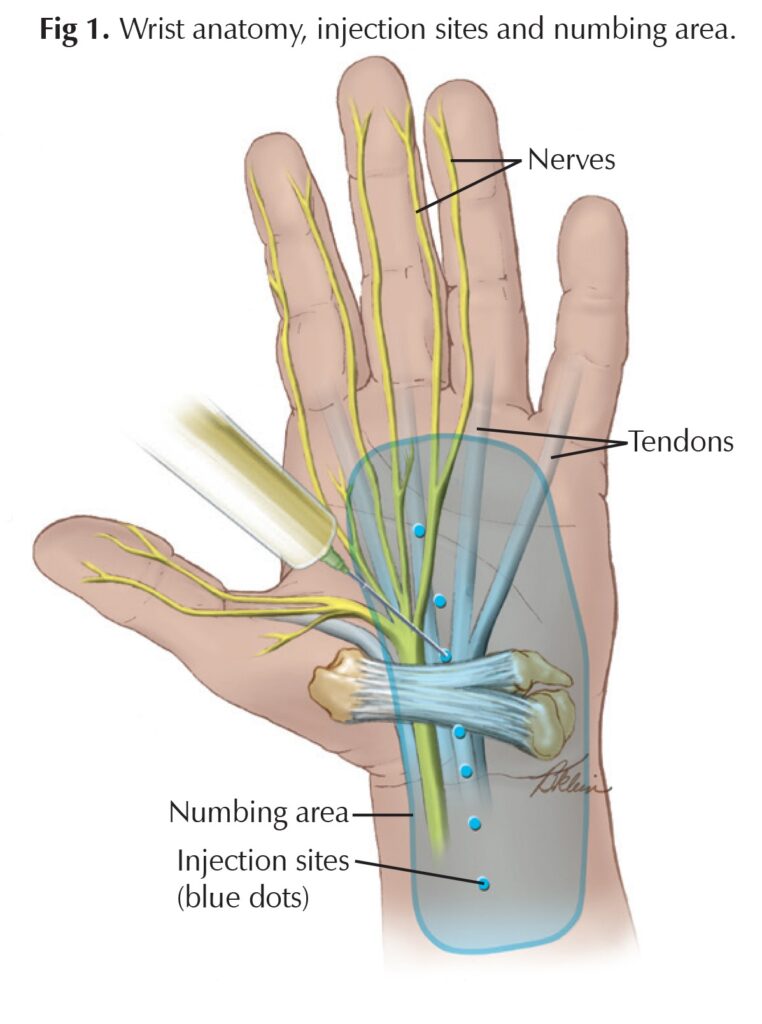
 Wide-awake local anesthesia no tourniquet, or WALANT, is an anesthetic technique used by surgeons to achieve pain control at the procedure site through a local injection. Most surgeons use WALANT in the upper extremity for cases such as trigger finger release, carpal tunnel release, flexor tendon repairs, and fracture care; however, the technique is gaining popularity for other areas, including trauma and foot and ankle surgery.
Wide-awake local anesthesia no tourniquet, or WALANT, is an anesthetic technique used by surgeons to achieve pain control at the procedure site through a local injection. Most surgeons use WALANT in the upper extremity for cases such as trigger finger release, carpal tunnel release, flexor tendon repairs, and fracture care; however, the technique is gaining popularity for other areas, including trauma and foot and ankle surgery.
Dr. Donald H. Lalonde first described using wide-awake local anesthesia with no tourniquet in treating operative hand cases. Since its introduction in the 1990s, WALANT has continued to gain popularity among surgeons with high patient satisfaction and clinical outcomes. The surgeon uses a very small needle to inject a mixture of lidocaine, epinephrine, and bicarbonate. Lidocaine is used as a local anesthetic or numbing medication to block pain, while epinephrine causes vasoconstriction and prevents bleeding. Sodium bicarbonate buffers the solution to make it less painful. This anesthetic technique allows the patient to be awake during their surgical procedure without pain from the surgery or from a tourniquet.
Steps for an effective WALANT procedure
The surgeon first sees you in the preoperative waiting area to mark the surgical site and explain the procedure in detail. After the staff moves you to the operating room, the physician presses firmly near the injection site to help decrease the initial needle stick you will feel. The doctor stabilizes the syringe with the injection using both hands and slowly injects a small amount under the skin. The surgeon then asks you to say when the pain has stopped from the initial needle stick. At that time, the physician slowly injects more of the local anesthetic mixture. Ideally, you will only feel the first part of the injection. The surgeon then continues to inject the operative site with the anesthetic mixture to ensure you gain the full anesthesia effect.
Can I feel anything during a WALANT procedure?
You will feel the initial part of the injection, similar to an IV, which is what you would otherwise feel if you had surgery under general anesthesia. During the procedure, you may be able to feel that the surgeon is doing something, but you do not feel anything painful. What you can do is move your hand, if instructed to do so by your surgeon, and you can listen as the surgeon tells you what is happening. You can bring headphones to listen to music or watch a video to distract yourself if you believe this awareness may bother you.
What are the benefits of WALANT?
Some of the major benefits of WALANT surgery include what you don’t need, such as no required preoperative testing, no IV line, no formal sedation, and no monitoring during the procedure. In some cases, anticoagulation medications (blood thinners) may be continued. You may drive yourself to and from surgery. If you want, you can go back to work the day of surgery if your physician approves. You do not have to fast prior to surgery. There is no tourniquet pain. It is safe and preferred for patients with poor peripheral circulation, vascular conditions, and extensive heart or lung conditions.
Another added benefit is the ability for you to participate by moving your extremity as indicated by the surgeon depending on the surgical procedure. Staying awake and engaged for the procedure helps both you and the surgeon. Active participation offers many advantages for the surgeon to evaluate the success of the surgical procedure. You have the ability to perform active range of motion, enabling surgeons to assess the procedure and make adjustments if necessary. You can also visually see the results of the procedure, which can be helpful during rehabilitation.
Over the past decade, the WALANT technique has proven to be valuable to both patients and surgeons by optimizing patient satisfaction and providing substantial healthcare savings. The advantages of WALANT offer patients the convenience of fewer office visits by avoiding the need to obtain preoperative clearances and presurgery fasting. Some surgeons perform the procedures in an office setting while others use surgical centers, which result in sizeable cost savings.
What are the potential side effects or complications?
Sometimes, nervous jitters or trembling can occur after an epinephrine injection. You may feel a little jittery or shaky after the injection, which is similar to the feeling after consuming too much coffee or caffeine. Physicians consider this a normal reaction to the numbing medication, and it will go away after approximately 20 to 30 minutes. Additionally, the use of epinephrine can cause an elevated heart rate in patients with cardiac conditions, but these risks are also minimal. Overall, the risk of complications from WALANT remains low. With the benefits to the patient and healthcare system, the usage continues to grow.
What happens after my surgery with WALANT?
After surgery using WALANT, your nursing staff will take you to the outpatient area where the surgeon can talk to you about the procedure and your postoperative care. Often, the lidocaine with epinephrine can last for several hours; however, you can go home soon after your procedure because you do not have to wait for the effects of general anesthesia or sedation to wear off. Before you leave, your surgeon’s staff will schedule your first follow-up appointment, typically within 10 to 14 days.
Author: Thomas Brent Anderson, DO | Columbus, Georgia
Last edited on July 15, 2025